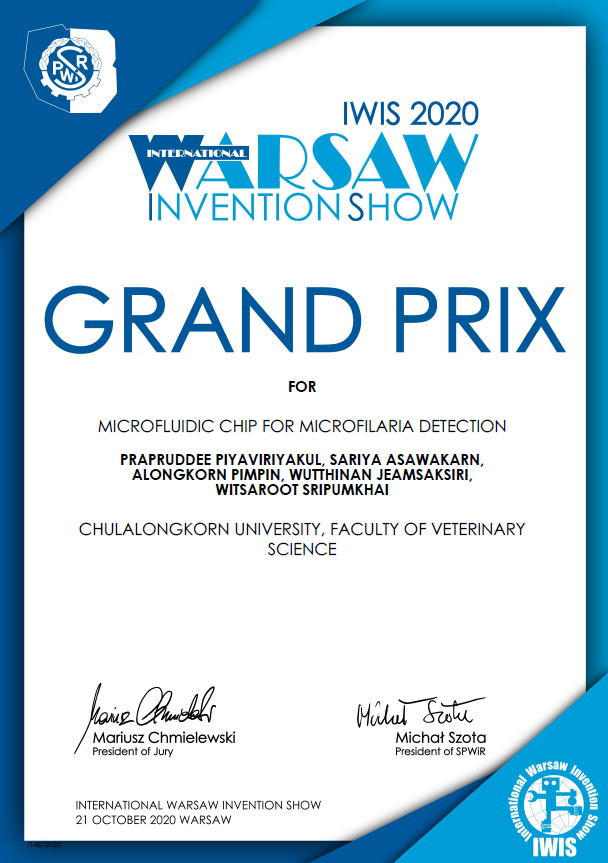The “Microfluidic Chip Device for Microfilaria etection” by Chula researchers has won the Grand Prize and the Gold Medal in the 14thInternational Warsaw Invention Show (IWIS 2020) in Poland. The Microfluidic chip device for microfilaria detection is considered cutting-edge andwas created through the research of Asst. Prof. Dr. Prapruddee Piyaviriyakuland Assoc. Prof. Dr. Sariya Asawakarnfrom the Department of Physiology, Faculty of Veterinary Science and Assoc. Prof. Alongkorn Pimpin, from the Department of Mechanical Engineering, Faculty of Engineering.

Asst. Prof. Dr. Prapruddee Piyaviriyakuland
Asst. Prof. Dr. Prapruddee explained that the microfluidic chip device makes the detection of microfilaria and heartworm larvae in dogs and cats quick and easy, without the need to use strong chemicals that are harmful to users and the environment. This innovative system replaces the conventional diagnosis by microscope, which may or may not clearly show the larvae because of the many red blood cells present. Although each diagnosis has its pros and cons, the Microfluidic chips offer a new alternative. The chip is created in cooperation with the Microelectronics Technology Center of the National Science and Technology Development Agency (NSTDA).

Assoc. Prof. Dr. Sariya Asawakarnfrom
“Heartworms can be found in both dogs and cats in many countries around the world. Fortunately, there are some preventative drugs for heartworm in dogs and cats that help keep the disease under control”, explained Asst. Prof. Sariya.

The microfluidic chip device
To detect whether heartworms are present, blood is drawn from a dog or cat, and then injected into the chip. The chip will filter out the red blood cells to detect the parasites’ tubular bodies and holed-cell walls. The parasites are pushed to the end of the tube while the red blood cell flow out of the system at the beginning of the tube. This solves the problem of red blood cells shielding the parasites, making them easier to detect.
Asst. Prof. Dr. Prapruddee revealed that the hallmarks of this award-winning innovation are successful integration of research with the use of new technology to produce an easy-to-operate, simple, and durable device which is practical in the real world and can deliver results swiftly.

Assoc. Prof. Alongkorn Pimpin
“The microfluidic chip has received two major awards from this contest. Not only is it easy to operate, it also has a wider market in the international arena as the spread of heartworm disease in dogs and cats has drastically increased in many places around the world, including Europe”, added Prof. Dr. Alongkorn.
Although the chip is still a prototype, it has been patented and will be developed and manufactured for use in pet clinics and animal hospitals in the near future.
For further research, the researchers from the Faculty of Veterinary Science and the Faculty of Engineering, Chulalongkorn University, will use the microfluidic chip to study the segregation of parasite strains in dogs and cats, adding to the parasite database and benefiting the field of epidemiology as a whole.

